G1676
Ascochyta Blight of Chickpeas in Nebraska
Ascochyta blight is the most serious chickpea disease worldwide. Integrating genetic resistance, crop rotation and fungicide application is the best way to manage the disease.
Robert M. Harveson, Extension Plant Pathologist
Carlos A. Urrea, Dry Bean Breeder
Introduction
The chickpea (Cicer arietinum), also known as the garbanzo bean, is an annual grain legume crop that ranks among the world’s three most important pulses (seed legumes used as food). It is an important source of protein in many parts of central Asia, Africa, and the Mediterranean, and among food legumes it is the most effective in reducing blood cholesterol levels. India is the largest producer, currently growing 78 percent of the world’s crop, followed by Pakistan, Mexico, Turkey, and Ethiopia. The crop is native to western Asia and the Middle East, and it is usually grown as a rain-fed, cool-weather crop or as a dry-climate crop in semiarid regions.
Interest in chickpea production in the United States as an alternative crop to spring cereals has increased rapidly in the Pacific Northwest where rainfall is marginal. The leading producers currently in the United States are Idaho, Washington, California, and North Dakota. Due to a number of issues including agronomic, processing, and marketing constraints, production in the central High Plains has been sporadic. However, production in Nebraska, has fluctuated substantially over the past decade, with a high of more than 10,000 acres in 2006. Despite a reputation for poor yields, chickpeas have the potential for more than 4,000 lb/acre, and production is expected to increase in the foreseeable future.
Symptoms
Although chickpeas are reported to be susceptible to more than 50 pathogens, few diseases are currently recognized as significant economic constraints to production. Ascochyta blight, caused by the fungal pathogen, Ascochyta rabiei, is the most serious chickpea disease worldwide. The pathogen attacks all aerial portions of the plant. Lesions (¼ to ½ inch in diameter) on pods (Figure 1) and foliage (Figure 2) tend to be circular while those developing on petioles and stems are usually elongate (Figure 3). Dark brown lesions on pods and leaves contain concentric rings of pycnidia, the spore-bearing structures (Figure 4), and are visible with a 10x hand lens. Early in the season, individual plants infected as seedlings are found scattered in fields (Figure 5). These plants may serve as foci from which disease progresses to other plants in the event that adequate environmental conditions occur (see Infection and Survival). This disease can cause economic losses due to reduced yields as well as reduced quality. For a crop like chickpeas, quality may be more important than gross yields, as payments for small discolored seeds (a result of pod and seed infection) are significantly lowered (Figure 6).
 |
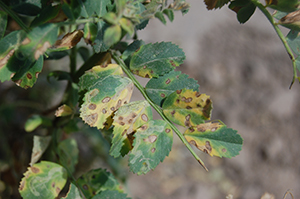 |
|
Figure 1. Circular lesions typical of pod infections due to A. rabiei. |
Figure 2. Circular lesions typical of leaf infections due to A. rabiei. |
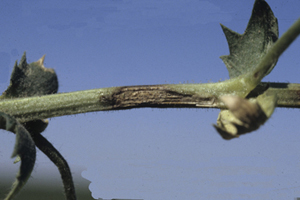 |
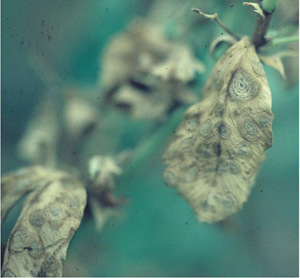 |
|
Figure 3. Elongate lesions typical of stem infections due to A. rabiei. |
Figure 4. Circular foliar lesions showing pycnidia arranged in concentric patterns within lesions. |
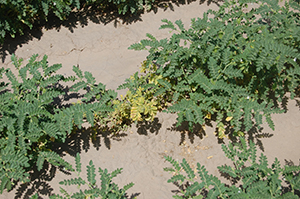 |
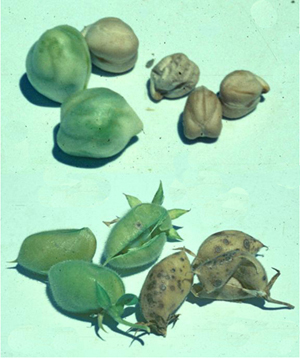 |
|
Figure 5. Individual, early-infected plant that may serve as a disease focus for other plants in the field. This plant likely originated from an infected seed. |
Figure 6. Effect of infection on seed size and quality. Seeds (top) harvested from pods (bottom) collected from a severely infested field — healthy (left) and infected (right). |
Infection and Survival
Disease development is most rapid at temperatures of 68-70° and high relative humidity. Blight will not develop at temperatures outside the range of 40-90°F or leaf wetness periods of less than six hours. Spores are released from pycnidia during humid weather in slimy, wet masses and are spread to new plants in fields by rain splashing and winds. Spores germinate 12 hours after landing on the host surface and penetrate and infect tissues after 24 hours. The pathogen can survive in infested residue in soils under dry conditions for at least two years. However, viability of the fungus is lost rapidly under conditions of high humidity (65-100 percent relative humidity) or when buried in soil.
The pathogen also can be carried over in seed and can grow from the pod wall into immature seeds. Between 50 and 80 percent of seed from infected pods were found to be infected with the pathogen, but seed collected from healthy pods on the same plants were not infected. Seed infections can be either internal or external on the seed surface, and both types of infections are equally capable of transmitting the pathogen to emerging seedlings. A. rabiei can retain its viability in seed for at least five years, and seed transmission is a more effective source of infection than is infected plant debris. Seed infections are also the most likely mechanism for long-distance spread of the disease throughout the world.
Disease Management
Since no one method of control for Ascochyta blight will be completely effective by itself, the best option for managing this disease is an integration of several different techniques. These include genetic resistance if available (combined with seed treatments if necessary), rotating chickpeas with nonhost crops for three to four years, and judicious usage of fungicides when warranted. Monitoring favorable conditions for disease development additionally assist growers in making the right decision to use a fungicide.
Crop Rotation
Since A. rabiei is specific for chickpeas, rotating with nonhost crops will help reduce inoculum levels in soils. Chickpeas should not be grown more frequently than every three to four years, and new crops should not be planted near previously blighted fields due to risk of infection in new crops. Tilling and burial of residue will speed up decomposition of infested residue which also will reduce inoculum by removing the source for the pathogen to survive in soils.
Resistance
No resistance is available that is complete or exhibits immunity from the pathogen (Figure 7). Most cultivars have good resistance until flowering when lesions may develop on stems and leaves. If conditions are favorable, disease can develop rapidly after flowering, and fungicide applications should be considered. Cultivars are available with partial tolerance resistance to the pathogen, and more are currently being developed and evaluated at the Panhandle Research and Extension Center in Scottsbluff (Figure 8).
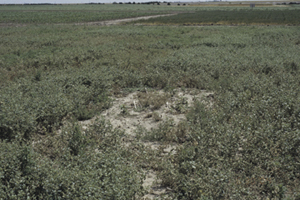 |
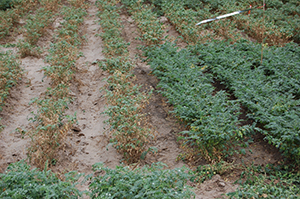 |
|
Figure 7. Chickpea cultivar trials showing entry highly susceptible to Ascochyta blight. |
Figure 8. Evaluating breeding lines for resistance to the pathogen. Note the growth and yellowing of the two rows on the left compared to the more tolerant rows on the right. |
Fungicide Applications
Producers should pay particular attention to protecting young green foliage during pod fill. In the past several strobilurin fungicides have successfully reduced damage from this disease, such as Quadris® (azoxystrobin), and Headline® (pyraclostrobin). However, due to populations of the pathogen being recently identified in Nebraska that are resistant to this class of fungicide, other modes of action should now be utilized for control. Endura® (Boscalid), Proline® (prothioconazole), Vertisan® (penthiopyrad), and Priaxor® (fluxapyroxad + pyraclostrobin) are labeled and have differing modes of action. All fungicides have been demonstrated to increase yields and reduce losses from the pathogen, but their use will not be economically feasible unless disease pressure is high. Watching weather reports and monitoring environmental conditions for disease development are useful methods for estimating need and timing for fungicide applications. Scouting fields early for the presence of isolated, infected plants is also an important part in this process. These isolated plants likely originated from infected seeds, and can rapidly spread to surrounding plants if left unchecked during favorable conditions for blight to occur.
Treating fields at an early stage is much more effective than rescue treatments after an epidemic has begun. Fungicide usage with these products has been shown to completely shut down disease activity of A. rabiei and allow for additional regrowth and flowering of infected plants (Figure 9).
Several seed treatments are available for early season disease protection, including Maxim® (fludioxonil), Apron® (mefenoxam), and Allegiance® (metalaxyl); however, these will only protect against seedling damping-off from certain soilborne pathogens such as Pythium and Fusarium. They will not protect plants from seedborne A. rabiei infections (Figure 10). Mertect® (thiabendazole) is labeled as another seed treatment specifically to protect against seedborne Ascochyta. For the latest information on labeled and appropriate use of fungicides for management of Ascochyta blight, contact the University of Nebraska Panhandle Research and Extension Center, 4502 Avenue I, Scottsbluff, NE 69361-4939.
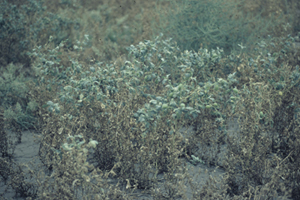 |
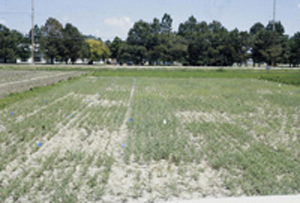 |
|
Figure 9. Regrowth of new foliage several weeks after application with fungicides. |
Figure 10. Poor stands due to seedborne Ascochyta blight in plots untreated with fungicides, compared to those using fungicides. |
This publication has been peer reviewed.
DisclaimerReference to commercial products or trade names is made with the understanding that no discrimination is intended of those not mentioned and no endorsement by University of Nebraska–Lincoln Extension is implied for those mentioned. |
Visit the University of Nebraska–Lincoln Extension Publications website for more publications.
Index: Plant Diseases
Field Crops
2007, Revised October 2013